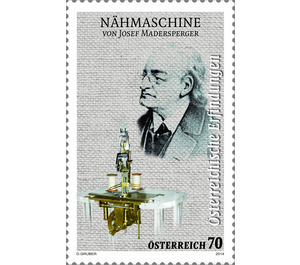inventor - Austria / II. Republic of Austria 2014 - 70 Euro Cent
Theme: Well-known people
| Country | Austria / II. Republic of Austria |
| Issue Date | 2014 |
| Face Value | 70.00 |
| Edition Issued | 700,000 |
| Printing Type | offset |
| Stamp Type | Commemorative |
| Item Type | Stamp |
| Chronological Issue Number | 2478 |
| Chronological Chapter | OOS-OE2 |
| SID | 249318 |
| In 61 Wishlists | |
He devoted his life to the construction and perfection of the "sewing hand". Although he is not today considered the sole inventor of the sewing machine, his trailblazing pioneering work is undisputed. The Austrian Post honors the innovative master tailor Josef Madersperger, who was no longer allowed to witness the worldwide triumph of the sewing machine, with a special stamp. Born on October 6, 1768, the son of a master tailor, the young Kufsteiner Josef Madersperger soon followed in the footsteps of his father. At the age of about 20, he moved to Vienna and established himself here as a tailor - his main focus, however, was probably less on the arduous tailoring than on the development of an apparatus that should facilitate this a lot. The first attempts to imitate the human sewing movements by machine, Madersperger undertook already at the turn of the century. Soon he started to use a needle that was pointed at both ends with an eye in the middle - so the needle could be guided alternately from top to bottom and vice versa by means of two grippers. Still not satisfied with his work, he eventually developed a needle with its eye on the point of the needle. This only pierced through the fabric from above and pulled a warp thread through a thread loop on the underside. A system that formed the basis of modern sewing machines. Madersperger was looking for his sewing hand in 1814 for the award of a k. k. Privilege, but could not afford the cost of protecting his invention, which is why the privilege only four years later extinguished. In 1835, at a trade exhibition in Vienna, he presented the double fabric invented by him and suitable for warm clothing, which he made on the meanwhile fifth version of his sewing machine; a few years later, the bronze medal was awarded by the Lower Austrian Trade Association. All this, however, did not contribute to the commercial success of his significant invention - Josef Madersperger died destitute on 2 October 1850 in the Vienna Versorgungshaus. In 1846, US American Elias Howe filed a patent for a double-stitch sewing machine, which gave him and Isaac Merritt Singer, who founded industrial sewing machine production, great fortune. The special stamp "Sewing Machine - Josef Madersperger" continues the series "Austrian Inventions". The motif shows next to the first posthumously acknowledged inventor his "Iron Hand", which he in 1839 the then Viennese k. k. Polytechnic Institute (the later Technical College) bequeathed and now one of the most popular showpieces of the Technical Museum in Vienna.


